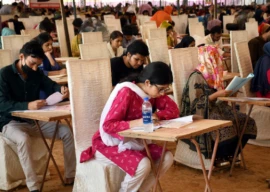
The provincial capital, once known for its lush green gardens, has become a dense jungle of housing schemes and shopping plazas, where preserving nature is neither profitable nor prioritized.
Ayesha Amir, a resident of Johar Town, reminisced about a time when the lush green plains of the city were a habitat for nightingales, red songbirds, woodpeckers, and Indian rollers. “Today, one can only spot crows and kites flying across the skies of Lahore,” she regretted.
Similarly, Abdul Rehman, a resident of Baghbanpura, resented the loss of greenery accompanying the wave of industrialization in the city. “Building new housing schemes and shopping malls destroys trees and gardens. The consequences of the rampant deforestation are seen in the form of air pollution and smog. It appears that in the coming years, it might not be possible for the future generations to survive without a mask,” opined Abdul Rehman.
Speaking to The Express Tribune, the Secretary of the Punjab Environmental Protection Agency, Raja Jahangir Anwar, said, "Around 400 large and small housing schemes alongside 250 multi-storied buildings have been built in Lahore. Although urbanization and development is encouraged the world over, other countries prioritize a controlled ecosystem. Rules stipulate that any housing society, petrol pump, or factory will plant trees on a fixed part of its area but unfortunately there is no regulation of these guidelines,” said Anwar.
In fact, despite international standards recommending the green cover area to be approximately 36 per cent of the total area, Lahore’s greenland is barely 3.3 per cent of the total land, while trees occupy less than one percent of the area. As per a report published by the Urban Unit Punjab, the built-up area of Lahore in 2000 was 438 square kilometres which has now expanded to 759 square kilometres. Conversely, over the past two decades, the total area of agricultural land in the city has reduced by almost 25 per cent, with 1,161 square kilometers of agricultural land in 2000 and just 873 square kilometers of green land in 2024.
According to Badar Munir, Former Chairman of the Chief Minister’s Task Force for Forests and Wildlife Punjab, Lahore, which was once known as the city of gardens, has now become desolate.
“Politicians and the civil society are all responsible for the damage done to the future of this city. When a 30-year-old tree is cut down and a few-month-old plant is planted in its place, the original plant cannot be replaced. We have to impose a complete ban on the cutting of trees while planting should be made mandatory in each sector. Native plants like java plum, the golden shower tree, neem and the sacred fig should be planted,” suggested Munir.
Director General Parks and Horticulture Authority (PHA) Muhammad Tahir Wattoo told The Express Tribune that work was underway on two projects to increase the number of green cover and trees in Lahore, where 80 to 90 million new plants are to be planted.
“A project called Tracking Tree has been started under which saplings will be planted and monitored. Another pilot project called the Environmental Positive Action is being started in Punjab under which there are 27 sectors which will be given green points for changing their traditional method to an environment-friendly method,” claimed Anwar.







1724319076-0/Untitled-design-(5)1724319076-0-270x192.webp)
1726732405-0/Express-Tribune-Web-(15)1726732405-0-270x192.webp)



1734953448-0/Express-Tribune-(7)1734953448-0-270x192.webp)


1735025557-0/Untitled-(96)1735025557-0-270x192.webp)











COMMENTS
Comments are moderated and generally will be posted if they are on-topic and not abusive.
For more information, please see our Comments FAQ